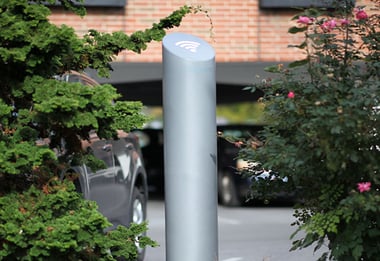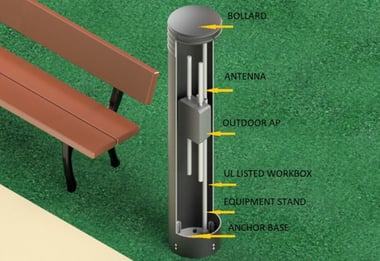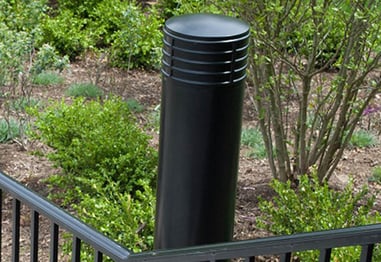With the requirement for ubiquitous Wi-Fi coverage, many network designers and installers need to place Wi-Fi access points in many outdoor locations. Wi-Fi Bollards facilitate installation.
Outdoor Network Considerations
Wi-Fi integrators often need to extend the premise network into outdoor areas in college, healthcare, and corporate campuses, and in smart city applications. The outdoor installation creates its own challenges for the premise network designer and installer (NDI) as it involves Outside Plant considerations, which are different from day-to-day indoor network installation challenges. The NDI must carefully consider equipment physical protection, weather protection, temperature extremes, solar loading, aesthetics, lightning protection, and installation cost – typically much higher than an indoor installation.
In many cases, the NDI will consider mounting access points on building walls or on top of buildings, on existing outdoor lighting poles, or even in or on the ground. These fallback installation methods face push back from campus stake holders because of aesthetics, maintenance, powering, or performance and location issues.
Oberon’s NetPoint™ Wireless Bollards
Oberon has developed the Wi-Fi Bollard™ as a purpose-built, stand-alone facility to assist the Wi-Fi network designer and installer achieve multiple objectives which otherwise are difficult to attain. Oberon’s Wi-Fi Bollards are comprised of an internal anchor base, an equipment stand for antennas and access points, the bollard cover, and, optionally, a UL listed, NEMA 4 workbox for AC line powered circuits.
Benefits to the Network Design
Wi-Fi Bollards assist the NDI with outdoor Wi-Fi in the following manner:
- Performance – The Wi-Fi Bollard allows the designer to place the AP and antenna precisely where it is needed– near the client devices. Installation on buildings or existing light poles puts the APs where the structure is, typically is not where the Wi-Fi signal is desired.
- Protection- the Wi-Fi Bollard protects the equipment (APs, Antennas, cables, media converters, power injectors, etc.) from tampering, vandalism and the elements. Additionally, equipment mounted in bollards is less likely to be affected by lightning than equipment mounted on top of buildings or light poles.
- Aesthetics – the Wi-Fi Bollards conceal the equipment in a visually benign enclosure. The Wi-Fi Bollards are available in a variety of shapes, colors, and sizes to suite the designer.
- Installation and Maintenance- the Wi-Fi Bollard is at ground level, and does not require a lift to install and service.
Oberon’s Wi-Fi Bollards come in two styles- the general purpose Model 3032, which has a low-loss rotomolded polyethelene plastic bollard, and the heavy-duty Model 3030, which has a low-loss, cast fiberglass bollard. Both are available in a number of colors.
Best Practices
Oberon recommends the following to Wi-Fi NDIs when designing outdoor networks.
- Place the access point close to where Wi-Fi clients will aggregate, such as building entrances, bus stops, swimming pools, and parking lots. Use antennas (directive or omni-directional) suitable for the application.
- Perform a site survey with access point and antenna at the planned location to get an accurate coverage map.
- Use outdoor access points and equipment suitable for the local environment.
- Consider solar loading on the equipment. Direct sunshine will impact equipment more than ambient temperature. (See Oberon’s article Solar Loading on Wi-Fi Bollards).
- Conductors entering buildings from outside should be appropriately surge/lightning protected.
- Mount AC line circuits in a UL listed, NEMA 4 work box.
- Use tamper-resistant screws or hardware to install the equipment or bollard.
- Consider using the Wi-Fi Bollard as an outside consolidation point. The bollard may provide additional power and data connectivity with installed outlets.





.png?width=58&height=58&name=X_logo_2023_(white).png)
